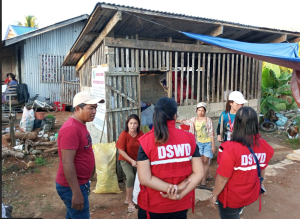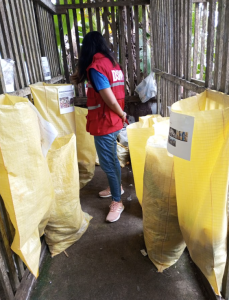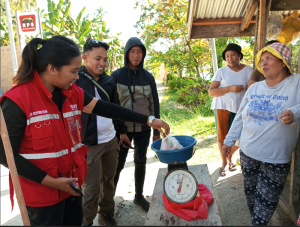
In a transformative move toward sustainable living, the municipality of Loreto, Province of Dinagat Islands, set the stage for a groundbreaking decade-long journey as it implemented a Waste Analysis and Characterization Study (WACS).
According to the National Solid Waste Management Commission (NSWMC), solid waste management remains a major challenge in the Philippines, especially in urban areas. Improper waste disposal, inefficient waste collection, and a lack of disposal facilities are among the dominant concerns in the country’s solid waste management. Unless these are addressed, the waste generated from various sources will continually lead to health hazards and serious environmental impacts such as ground and surface water contamination, flooding, air pollution, and the spread of diseases.
Based on the NSWMC’s 2012–2016 survey, the Philippines’ waste generation continues to rise with the increase in population, improvement of living standards, rapid economic growth, and industrialization. In the Caraga Region, from 884.69 tons per day in 2012, it rose to 947.57 tons per day in 2016.
For years, the residents were passive participants in the critical task of waste segregation and waste disposal. And today, a renewed sense of responsibility is sweeping through the neighborhood.
Seeking to optimize waste management and get updated waste generation in the to wn, the municipality of Loreto, PDI, collaborated with the Department of Social Welfare and Development (DSWD) Field Office Caraga through its Risk Resiliency Program—Cash for Work/Training (RRP-CFW/T) to address pressing issues like waste management.
RRP is a convergence program that will operationalize climate change adaptation and mitigation, enabling climate- and disaster-resilient communities.
Aimed at unraveling the composition of the municipality’s waste, the Waste Analysis and Characterization Study (WACS) is a comprehensive process designed to gather crucial information on the quantity and composition of solid waste generated by the residents of the municipality of Loreto, which comprises 10 barangays: Carmen, Ferdinand, Esperanza, Panamaon, and Sta. Cruz, San Juan, Santiago, Liberty, Helen, and Magsaysay.
The study delved into the intricate details of waste generation, measuring parameters such as tons per day, cubic meters per day, and kilograms per household in a day. It was implemented for ten days, covering a market day, an ordinary day, and a weekend.
The WACS implementation formed part of the municipality of Loreto’s formulation of its visionary 10-year Waste Management Plan.
The results of the study were eye-opening; from identifying the prevalent contaminants in recycling bins to spotlighting the potential organic waste diversion, the data painted a vivid picture of Loreto’s current waste landscape.
“Ang initial results sa WACS is niubos ang ilang waste generation especially ang mga biodegradable kay ang reason ngano niubos ang result sa biodegradable is wala kayo nacollect ang malata especially dili season sa ting tanom during sa ato pag-implement sa WACS, so mao ni taas2 ang account sa recyclables. Ang impact nga nakita nila run sa WACS sa mga beneficiaries is na-refresh sila ge balik sa proper waste disposal and segregation kay before, ang uban residents mo-direct og labay sa ila waste sa ila eco-park which is ginabawal nila dili ma monitor ang segregation. After atong WACS gina-segregate na sa residents ilang waste kay ang biodegradable is sa ilang MRF nila ilabay kay didto ang collection point sa ilang munisipyo sa ilang mga basura”. [The initial result of WACS is a decrease in waste generation, especially with biodegradables, because of ‘no biodegradable collection’, especially since it is not cropping season during the WACS implementation, which resulted in a higher account of recyclables. Beneficiaries of WACS have observed a noticeable impact on the restored understanding of proper waste disposal and segregation. Previously, residents would directly throw their waste into the eco-park, which was then prohibited to prevent unmonitored segregation. After WACS implementation, residents learned to segregate their wastes, where biodegradables are thrown into their Materials Recovery Facility (MRF), the municipality’s collection point for their waste], Roceller Yanag Abis, the MENRO Loreto Technical Staff expressed.

“The impact of WACS is the updated waste generation data in Loreto [PDI] as an accurate basis for waste management planning. We are compliant with waste management. We now have segregation and source, collection of segregated waste, and others”, Renato H. Tubo, MENRO Loreto Designate, said.
The collaboration between the RRP-CFW/T and WACS in the municipality of Loreto not only addressed the immediate economic concerns but also laid the groundwork for a sustainable and resilient future. With WACS, the municipality’s commitment to turning waste into wisdom exemplifies the power of local action in the global pursuit of a greener, healthier planet and in lowering health hazards.
DSWD commits to empowering communities across the nation by building disaster-resilient foundations and encouraging the public to join hands in shaping a future where disasters no longer leave a trail of devastation but opportunities for communities to showcase their strength, resilience, and unity.


